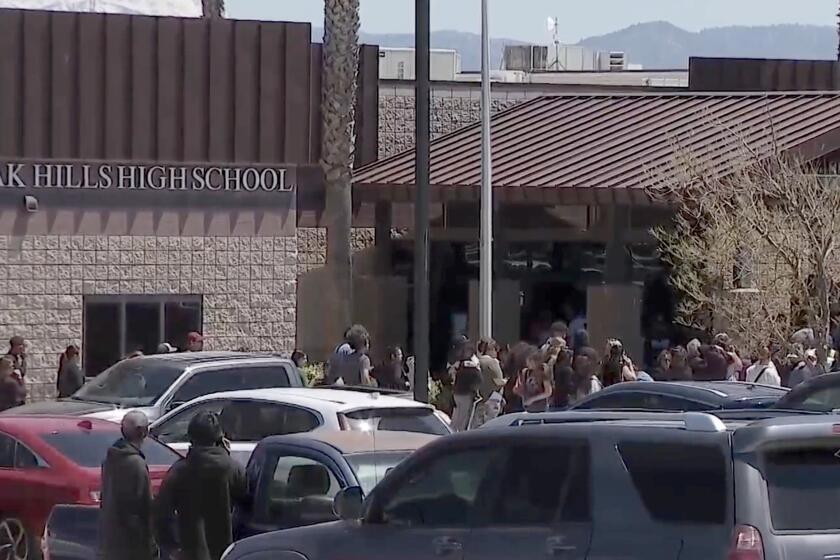Communities below Station fire burn area prepare for hard rain
A powerful winter-like storm is expected to batter fire-ravaged hillsides in Los Angeles County with 3 to 6 inches of rain beginning tonight and lasting through early Wednesday morning.
As news of the coming wet weather circulated Monday, residents in charred foothill areas scrambled to fill sandbags or pack their belongings and flee areas prone to flooding. Officials also worked to place huge concrete mudslide barriers along roads in areas including La Canada Flintridge.
The storm, which originated in the Gulf of Alaska, is expected to combine with moisture-laden remnants of a typhoon from the western Pacific, making the system wetter than normal, the National Weather Service said. On top of that, the storm system will be driven by strong winds blowing from the south, intensifying rainfall on the south-facing mountain slopes that burned from Altadena to Acton during the huge Station fire that broke out in August.
“We’re expecting a pretty good system to come through,” said Jamie Meier, a meteorologist with the weather service’s Oxnard office. “What’s making this so significant is that tropical moisture from the remnants of the typhoon is moving eastward and will interact with this storm system.”
For the last 30 years, Meier noted, the average rainfall for the entire month of October has been about half an inch. “This one storm will make it a wet October,” she said.
Last week, the U.S. Geological Survey released a sobering forecast for communities hit by the Station fire, saying major mudslides will be highly likely during the winter rain season.
Kevin Schmidt, a research geologist at the USGS, said Monday that the locations most at risk are in La Canada Flintridge, La Crescenta and a few areas of Pasadena sitting against the San Gabriel Mountains.
Los Angeles County Fire Department Battalion Chief Mike Brown, who commands rescue units in the La Canada Flintridge area, said personnel will be monitoring hillsides in the areas ravaged by the Station fire when the storm arrives. He said sandbags will be available for residents at all county fire stations. Some will also have sand available.
Olivia Brown of La Canada Flintridge had picked up 200 sandbags, which she was hoping to place around her house before the storm arrived. Standing behind her one-story stucco home Monday, she looked up toward the rugged hillside.
“All that is supposed to come down,” she said. “There are some big boulders up there. And we’ve had daily landslides since the fires. This is ground zero right here.”
Brown, 44, and her husband had already spent a week staking steel rods attached to wood logs into their backyard to divert debris away from their home on Ocean View Boulevard near Earnslow Drive. But over the weekend, they added an 8-foot-tall chain-link fence reinforced with railroad ties across the back of their house.
“I woke up with an anxiety attack,” she said. “We weren’t ready to have it this hard, this soon.”
In Vogel Flats, meanwhile, Bronwen Aker was busy Monday afternoon packing the contents of her one-bedroom cabin into cardboard boxes.
She said she was notified by the U.S. Forest Service to evacuate her home by Tuesday. Aker worried that if mudslides washed out nearby roads, she might not have another opportunity to gather family heirlooms, including her late grandmother’s collection of hand-woven baskets.
“I’m erring on the side of caution,” said Aker, 45.
She planned to put up plywood and a plastic tarp against the brick and knotty pine home that she’s lived in for 11 years near Big Tujunga Canyon Road. Built in the early 1900s, the cabin has been in Aker’s family for decades. It’s the same place where she nursed her ailing grandmother, who died last year.
“It’s not about losing money -- it’s about the memories here,” she said. “This is the first time I’ve been truly afraid of losing the house.”
--
robert.lopez@latimes.com
Times staff writer Baxter Holmes contributed to this report
--
BEGIN TEXT OF INFOBOX
Tips for dealing with mudslides
* Stay alert and awake. Many debris-flow fatalities occur when people are sleeping. Be aware that intense, short bursts of rain may be particularly dangerous, especially after longer periods of heavy rainfall and damp weather.
* If you are in areas susceptible to mudslides and debris flows, consider leaving if it is safe to do so. Remember that driving during an intense storm can be hazardous. If you remain at home, move to a second story if possible.
* Listen for any unusual sounds that might indicate moving debris, such as trees cracking or boulders knocking together.
* If you are near a stream or channel, be alert for any sudden increase or decrease in water flow and for a change from clear to muddy water.
* Be especially alert when driving. Embankments along roadsides are particularly susceptible to mudslides. Watch the road for collapsed pavement, mud, fallen rocks and other indications of possible debris flows.
* Follow evacuation orders and other instructions from local authorities and use your best judgment about leaving mudslide-prone areas.
* If escape is not possible, curl into a tight ball and protect your head. A tight ball will provide the best protection for your body.
Source: American Red Cross
More to Read
Start your day right
Sign up for Essential California for news, features and recommendations from the L.A. Times and beyond in your inbox six days a week.
You may occasionally receive promotional content from the Los Angeles Times.








